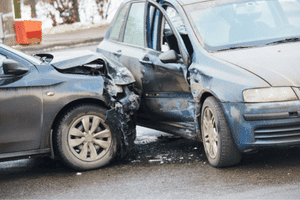
Figuring out who is at fault can be a complex process when a multi-car accident occurs. But there are established rules for making such determinations when a pile-up happens. Determining fault is an important step in the car accident injury claim process.
Rear-end crashes, head-on collisions, intersection crashes, and lane change accidents may occur singly or in combination in multi-vehicle mishaps. Here we’ll take a look at the basic sequence followed by law enforcement and insurance companies in determining which driver initially triggered the accident and whether other drivers are partially at fault.
What is the Definition of a Multi-Car Accident?
A collision involving more than one vehicle is considered a multiple car accident. From a relatively simple two-car crash to a chain reaction accident involving dozens of vehicles, the same rules are used to determine blame – whose insurance must pay for damages.
What Happens in Multi-Vehicle Chain Reaction Collisions
This is the type of accident we see too often on the news – usually occurring on multiple-lane interstate highways. On a crowded thoroughfare, one car rear ends another, then the cars in front or behind inadvertently continue the scenario, in a classic chain reaction, domino-effect manner.
In other instances of chain reaction crashes, varied types of accidents happen simultaneously. As drivers swerve in an attempt to avoid one vehicle, they impact others in a variety of ways.
Sometimes a weather event, like a snowstorm, ice storm, or dense fog, causes slippery conditions or visibility issues which contribute to the occurrence of a chain reaction crash. Still, someone is at fault, as drivers are expected to maintain appropriate conduct in consideration of current conditions.
Determining who is at Fault in a Chain Reaction Collision
In a classic chain reaction, multi-car rear-end collision, the same guidelines for determining fault are followed as in a basic two-vehicle rear-end collision.
But the first driver to impact another is usually determined to be most at fault. That’s because the rear vehicle is considered to have the greatest ability to avoid a crash. Drivers are expected to allow enough distance between their vehicle and the car ahead to stop in time no matter how quickly the vehicle in front of them puts on the brakes.
More Than one Driver may be at Fault in a Multiple Vehicle Accident
Though the first driver whose vehicle impacts another is normally deemed most at fault, other drivers may be considered to share responsibility for a multi-vehicle crash.
The law governing this principle is called comparative negligence. The actions of each driver must be “compared” and a percentage of fault assigned to each driver who an investigation determines to have been negligent to some extent.
Multi-Car Head-On Collision Accidents
A head-on collision occurs when a vehicle crosses the center line into oncoming traffic and directly impacts the front of a vehicle coming from the opposite direction. A head-on collision in heavy traffic can trigger additional collisions, thus creating a multi-vehicle accident.
Who is at Fault in a Multi-Car Accident When a Head-On Collision Happens?
Usually, the driver who crossed the center line will be considered most at fault, perhaps other drivers, to a lesser extent.
But if “Car A”, which crossed into oncoming traffic, hitting “Car C” head-on, was previously knocked off-course by another vehicle – “Car B”, initially, the driver of “Car B” would be considered the most at-fault driver, since “Car B” caused the initial impact.
Multi-Car Intersection Accidents
A multi-car intersection accident occurs when a driver fails to obey a traffic control device like a stop sign or stoplight. Accidents involving improper left turns are also common at intersections.
Who is at Fault in a Multi-Car Intersection Accident?
The same general rule applies to multi-car intersection accidents as to all types of vehicle accidents. The first driver whose vehicle impacted another (ran a stop sign, turned left in front of an oncoming vehicle, sideswiped an oncoming car, etc.) is normally considered the most at-fault driver.
Other drivers, however, may still bear a percentage of guilt also, if an investigation by law enforcement officials and insurance companies determines some could have avoided a collision.
Multi-Car Lane Change Accidents
Multiple lane highways are frequent scenes of this type of accident. Crowds of commuters guilty of distracted driving have been responsible for an increase in multi-vehicle lane change accidents. But they can happen on any street or road with more than one lane for traffic traveling in a single direction.
Who is at Fault in an Accident Involving an Improper Lane Change?
If two cars are traveling side by side in the same direction, and one car attempts to change lanes but impacts the other, causing it to clip additional vehicles, the car that caused the initial impact is the one whose driver is to blame. Rarely, some drivers, in addition to the one who initially caused the collision, may be determined to share responsibility if they were considered to have had the opportunity to avoid being clipped by driving more slowly or paying greater attention to the highway.
Determining fault after any car accident can be a tricky business, involving various entities. Assessing the level of responsibility for a multi-car collision can be even more complex and confusing. But the guidelines for determining which driver(s) are at fault are consistent, no matter how many vehicles are involved in a multi-vehicle accident.